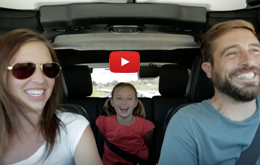Winter Camping in Colorado
Winter camping in Colorado can truly be an enchanting, unforgettable experience. You’ll find that braving the cold weather will warm your soul with a certain coziness and comfort. You can seek out extreme solidarity, natural stillness, and captivating views. While camping in the winter might seem too intense for some, being prepared and having the right gear will set you up for a great Colorado adventure.
Why You Should Try Camping In Winter
It may not sound too appealing to be camping outside at high altitude, with cold wind and snow blowing down from the mountains, but the rewards will certainly make it worthwhile. Chances are that when you look back on your winter camping experience, you won’t remember the cold, but you will forever remember the things you were able to see and do.
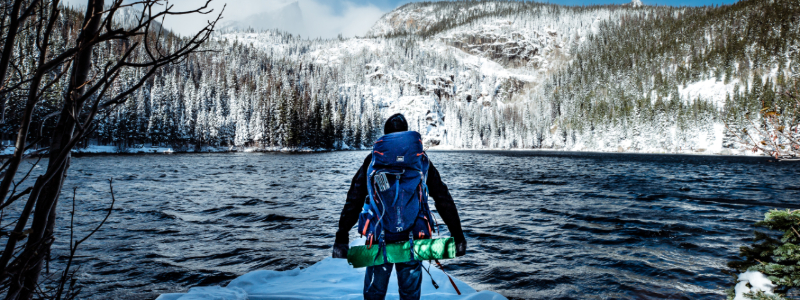
Scenic Views
It’s no secret that this state is home to some extremely charming settings. Many of which attracts plenty of tourism every year, no matter the season. Colorado winter camping puts you front and center of the iconic, majestic winter scapes that so many other people travel from afar to experience. It provides an intimate, exclusive view of the beautiful lakes, streams, meadows, and mountains that this area has to offer. In winter, these areas transform into a wonderland of blankets of snow and ice.
Peace and Quiet
There is a calming silence that comes with winter camping. As fresh snow accumulates on the ground, it acts as a sound absorber like other porous materials, such as fiber or foam. Snowflakes in the air limit the distance sound can travel, as it also absorbs sound waves. In the distance, the snowfall and the wind combine to make a still, white noise – essentially a silence you can hear. The sound of the campfire drowning out the white noise in the background warms the soul and soothes the mind. The cold weather doesn’t attract large crowds of campers as do the warmer months. With little-to-no other campers around…
you’ll be able to experience an inner peace with total solitude.
Mosquitos and other bugs aren’t around to bother you during the winter months, either.
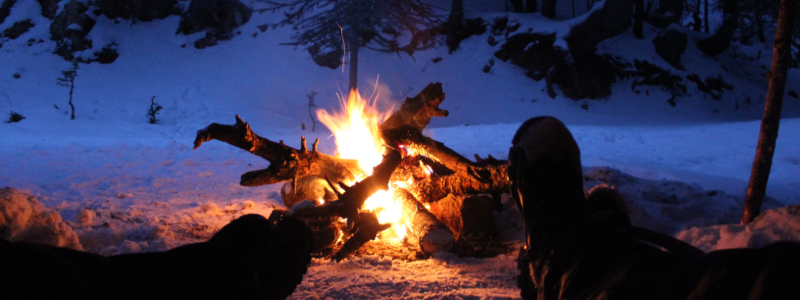
Proximity
If you’re a fan of other winter recreational activities like skiing, snowboarding, snowshoeing, tubing, or snowmobiling, you’ll find that camping puts you in the closest proximity to a lot of those activities in the Grand County area. There’s no dealing with highway traffic driving up to the resorts, or booking a costly reservation with a nearby hotel. Simply pack up your gear when you’re ready to leave the campsite and go enjoy other winter activities in Granby, Winter Park, Fraser, and other areas.
What To Expect
As a general Colorado rule of thumb, it’s always best to prepare for the worst of conditions while winter camping.
Preparing for things like strong winds or heavy snowfall will allow you to avoid problems and enjoy the experience to the fullest.
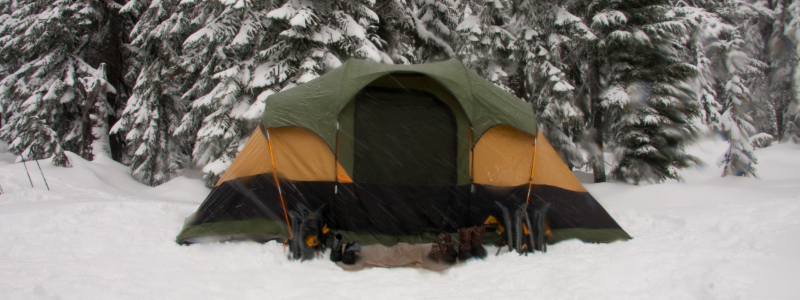
Preparing for Winter Camping
It’s going to be cold, so prepare accordingly.
Prepare your campsite by digging out the snow a couple of feet down and packing the bottom layer down with your snowshoes or boots. This will ensure that the snow doesn’t melt from underneath you as you sleep. It also prevents you from stepping through a soft snowdrift while in your tent, which could rip a hole in the bottom of the tent.
Build a wall around the perimeter of your tent to reduce wind impact, but make sure the tent still has room for ventilation. The tent will also need to be staked down by longer, tougher stakes that can penetrate the frozen ground, to keep it from blowing away in the wind. If stakes aren’t an option, you can stuff sacks full of snow, bury them, and secure them to the tent.
Staying Warm
Colorado does get cold, but it often warms up during the daytime. Take advantage of the sun being out and hang all items that need to be dried off on top of your tent. Remember to shed layers as it gets warmer, as sweat can become your worst enemy in the cold.
The secret to staying warm while camping in the winter is: snacking. Heat is produced as your body digests food, so you’ll stay a little warmer as proteins, carbohydrates, and fats are kept in your system. When you prepare meals, remember to think about how much time it takes to cook and also clean up. Your body will start to cool down while you sit to eat, so smaller meals and eating while moving will best help you stay warm.
Staying Hydrated
Maintaining hydration is key to a great winter camping experience. Even when you don’t feel thirsty, make sure you’re drinking plenty of water. Keep water bottles upside-down, as ice forms from the top down, your water supply isn’t blocked. Melting and boiling snow will be the best way of getting fresh water, as a lot of water purifying products don’t perform as well in cold temperatures.
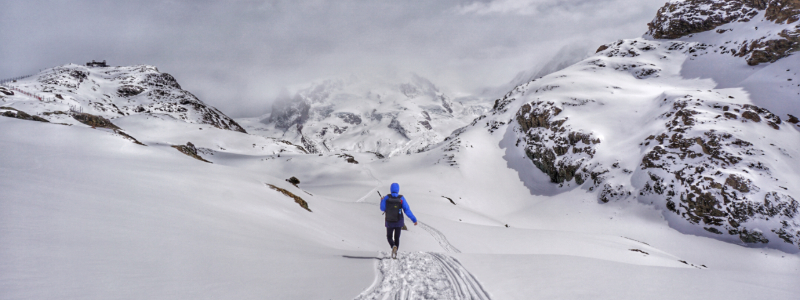
What To Bring
It’s always best to pack for one or two extra days while winter camping. Doubling up on a few items like an extra hat, gloves, and boots will keep you most comfortable. Storing all gear, other than sharp items (knives, shovels, etc), in the tent will also keep you warmer. Here is a suggested list of items to bring for Colorado winter camping:
- Two sleeping pads – Having more than one sleeping pad will give more insulation and keep you from losing body heat. The extra pad also serves as an insurance pad in case the other one is compromised.
- Tent – A 4-season tent will be best for keeping condensation away from your other gear. Plan for an extra person in the size of the tent you pack, so that you have enough room to store all other items.
- Backpack – Pack as lightly as you can, but choose a backpack that is also capable of carrying larger items, like snowshoes.
- Snowshoes – You’ll have an easier time walking around in the snow, for both short and longer distances.
- Headlamp – Make it easier on yourself to see in dark and snowy conditions.
- Sled – A sled will store extra gear you may need, without having to carry it all on your back. A sled is best for camping sites that require you to hike into the area.
- Backpacking stove – Keep it as light as possible. When cooking, place the stove on two or three branches to keep the stove from sinking into the melted snow.
- Base layer of clothing – Pick a fabric like polyester or wool that will keep your skin dry and has good ventilation.
- Middle layer of clothing – The middle layer is the insulation layer, so down jackets or heavyweight fleece are your best options.
- Outer layer of clothing – Considered the “shell” layer, choose a waterproof and breathable jacket that will protect against all elements.
- Winter hat – Choose a wool or synthetic hat that will cover your ears.
- Two pairs of gloves – Bring an extra set of gloves in case your first pair get wet, preferably insulated gloves with an outer layer.
- Socks – Non-cotton, so that your feet stay dry. Remember to pack a few extra pairs.
- Boots – They will need to be waterproof. Boots that have an inner liner are recommended, as you can keep the outer layer outside and bring the inner layer into your sleeping bag to keep them warm.
- Gaiters – Additional protection for your boots, to keep your feet dry.
- Vaseline – If there are parts of the body that are exposed to the elements for a long period of time, you can cover the area in Vaseline to maintain some warmth (an old Inuit trick with animal fats).
- Pillow – Non-cotton, to retain more body heat.
- Reflective blanket – For extra warmth and emergencies.
- Camera – The views during the winter are worth photographing. Keep camera batteries in your sleeping bag so that they’re always ready to operate.
- Goggles/Sunglasses – Your eyes will need to be protected from the wind and sun.
- Plenty of food – Always be snacking during your winter camping experience. Pack an extra day’s supply, as well.
- Compass – Keep track of where you are at all times.
- Insulated water bottles – Pack a few and keep them all at least ¾ full at all times.
- Pee bottle – Have an extra bottle clearly marked for peeing into at night, instead of having to go out into the cold.
- Knife – Any type of multi-tool is essential for helping with certain tasks, like cooking or starting a fire.
- Firestarter kit – Either a pre-assembled kit, or pack an axe, flint/steel, and matches or lighter.
- Wood – Keep the wood dry by storing in the car or a waterproof sack.
- Two tarps – Pack one to set over your kitchen area and the other to place over your tent for extra protection against moisture.
- Packable lanterns – Not only will lanterns keep light on areas, but if one is placed safely in the tent, it will add extra heat to the inside of the tent. Make sure it’s in an area that is fire safe.
- Whistle – For emergencies.
- Sunscreen – To protect against sun exposure.
Best Spots For Winter Camping
There’s no shortage of camping spots in Colorado, especially in the Grand County area. Some of those places suitable for summertime camping are just as great, if not better, in the wintertime. No reservations are needed, fire bans are not an issue, and areas will most certainly not be packed. Whether the spots are accessible via car or they require a short hike into the site, there are plenty of places to camp in the winter.
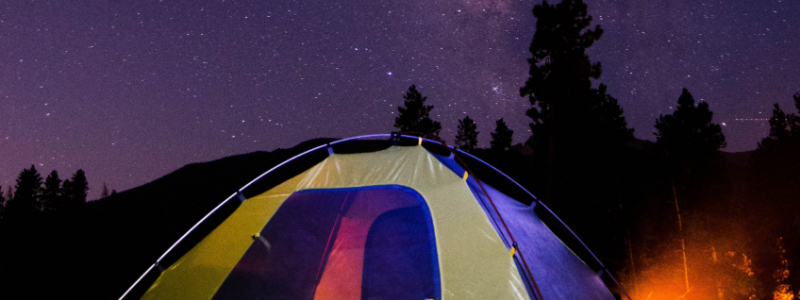
Arapaho National Forest
Arapaho National Forest sits on the continental divide and offers a variety of lakes and winter activities close by. Campgrounds in this area are accessible by vehicle, which means less hiking to find a camp spot. Keep a close eye, as this area is known to have a large amount of moose.
The Spots
Denver Creek Campground is one of the more secluded campsites in this National Park. It sits next to Willow Creek and provides plenty of backwoods trails for winter trekking. This area does not provide a lot of shade and cover, so plan accordingly.
South Fork Campground provides direct access to the South Fork Trail, a popular horse trail during the warmer months. Take advantage of the trails being less crowded, as it can get crowded all other times of the year, and for good reason – the views from this trail are captivating.
Sugarloaf Campground is nestled in the Williams Fork Valley, near the Williams Fork River. A lot of the trees in this area have been removed due to mountain pine beetle damage, so there isn’t a lot of tree cover. Wind does pick up in this area, as well, so plan accordingly.
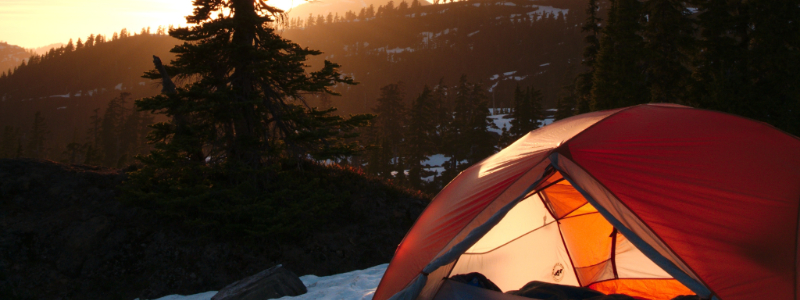
Rocky Mountain National Park
There is a wide of campgrounds in Rocky Mountain National Park that are open to the public and accessible with a vehicle. There are also plenty of trails in this area for cross-country skiing and snowshoeing. Please follow all National Park guidelines when camping in this area.
The Spots
Glacier Basin is one of the most popular campgrounds in RMNP, known for its picturesque views. There are designated campsites, but chances are you won’t be fighting for a spot in the winter. Bring your camera as there is a great view of Glacier Basin from the campground and some great open trails for exploring.
Longs Peak Campground is one of the highest camping areas in RMNP, as campers at this location are usually preparing to climb Longs Peak. However, climbing Longs Peak at this time of the year is not recommended. Some of the best views that this National Park has to offer are in this area.
Timber Creek Campground is located on the west side of RMNP, right next to the Colorado River. This area is known for its fly fishing and plenty of open spaces. If the cold weather is too much, there are hot springs nearby. Avoid parking where trees may fall.
Summed up
For a detailed list of other camping spots in the Grand County area, check out “Camping in Winter Park Colorado.”
It may seem inviting to stay under the warm covers and experience the mountains another time. However, you’ll find that with the right gear and preparation, Colorado winter camping provides a private, memorable experience of this state’s best features.





